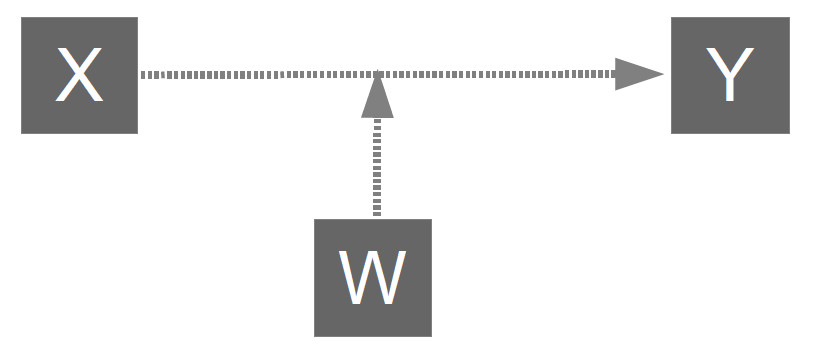PROCESS Version 3 & Version 4 - Key Model Templates
The most important models for mediation, moderation and moderated mediation with Hayes' SPSS macro
Arndt Regorz, Dipl. Kfm. & M.Sc. Psychologie, 31/10/2024
Hayes' PROCESS macro for SPSS (Hayes, n.d.) has become the de facto standard for modern mediation and moderation analyses. This tutorial shows the most important and popular model templates for PROCESS version 3 and version 4.
This short overview over different model templates for the PROCESS macro is based on the appendix A from Hayes' excellent book Introduction to mediation, moderation, and conditional process analysis: A regression-based approach (2017). If you are writing you master's thesis or dissertation based on PROCESS I can highly recommend reading this book. You will get much more in depth information about this topic than a short tutorial like this (or other similar ones) on the internet can give you.
I have limited this tutorial to the simpler model templates:
- Moderation
- Mediation
- Moderated mediation with one moderator only
If you want to run more sophisticated models (e.g. moderated mediation with two moderators) you will find the necessary information in Hayes' book.
Content
- Moderation
- Mediation
- Moderated mediation (moderation of the a-path)
- Moderated mediation (moderation of the b-path)
- Moderated mediation (moderation of the a-path and b-path by the same moderator)
- References
1. Moderation
If you want to run a moderation analysis you can choose from three different models:
- One moderator: model 1
- Two independent moderators: model 2
- Two interacting moderators (moderated moderation): model 3
Model 1 (one moderator):

Video tutorial how to calculate the needed sample size for a moderation analysis:
Power calculation for moderation analysis with G*Power
Model 2 (two independent moderators):

Model 3 (two interacting moderators):

Here you can find
my consulting services
for PROCESS models (which parameters to use, how to check the assumptions, how to interpret the output). In my experience, a one-hour consultation typically suffices for clarifying most open questions.
2. Mediation
If you want to run a mediation analysis you can choose from three different models:
- Simple mediation: model 4. This template can be used for parallel mediation, too.
- Mediation with a moderated direct effect: model 5
- Sequential mediation: model 6
Model 4 (Simple mediation):

Video tutorial how to calculate the needed sample size for a mediation analysis:
Power calculation for a simple mediation analysis
Model 4 (Parallel mediation):
(Here shown with two parallel mediators, but you can test more than two)

Video tutorial how to calculate the needed sample size for a parallel meditation analysis with two mediators:
Power calculation for parallel and serial mediation with a simulation-based tool
Model 5 (Mediation with moderated direct path):

Model 6 (Serial mediation):

Video tutorial how to calculate the needed sample size for a serial mediation:
Power calculation for parallel and serial mediation with a simulation-based tool
Here you can find
my consulting services
for PROCESS models (which parameters to use, how to check the assumptions, how to interpret the output). In my experience, a one-hour consultation typically suffices for clarifying most open questions.
3. Moderated mediation with moderation of the a-path
These models have an a-path (independent variable to mediator) which is moderated. Here, I am showing you the two simple models with one moderator only. For more complex models see Hayes (2017).
Model 7 (Moderated mediation with moderation of the a-path, but not of the c'-path/direct effect)

Video tutorial how to run and interpret this model:
Moderated Mediation with PROCESS model 7
Model 8 (Moderated mediation with moderation of the a-path and the c'-path/direct effect)

Video tutorial how to run and interpret this model:
Moderated Mediation with PROCESS model 8
Here you can find
my consulting services
for PROCESS models (which parameters to use, how to check the assumptions, how to interpret the output). In my experience, a one-hour consultation typically suffices for clarifying most open questions.
4. Moderated mediation with moderation of the b-path
These models have a b-path (mediator to dependent variable) that is moderated. Here, I am showing you the two simple models with one moderator only. For more complex models see Hayes (2017).
Model 14 (Moderated mediation with moderation of the b-path but not the c'-path/direct effect)

Video tutorial how to run and interpret this model:
Moderated Mediation with PROCESS model 14
(However, I strongly recommend not using this model template, but using PROCESS model 15 instead. Model 14 can lead to seriously biased results.)
Model 15 (Moderated mediation with moderation of the b-path and the c'-path/direct effect)

Video tutorial how to run and interpret this model:
Moderated Mediation with PROCESS model 15
Here you can find
my consulting services
for PROCESS models (which parameters to use, how to check the assumptions, how to interpret the output). In my experience, a one-hour consultation typically suffices for clarifying most open questions.
5. Moderated mediation with moderation of the a-path and the b-path
These models have an a-path (independent variable to mediator) and a b-path (mediator to dependent variable) that are moderated. Here, I show the two simple models with one moderator only. For more complex models see Hayes (2017).
Model 58 (Moderated mediation with moderation of the a- and b-path but not the c'-path/direct effect)

Model 59 (Moderated mediation with moderation of the a-path, b-path and the c'-path/direct effect)

Here you can find
my consulting services
for PROCESS models (which parameters to use, how to check the assumptions, how to interpret the output). In my experience, a one-hour consultation typically suffices for clarifying most open questions.
6. References
Hayes, A. F. (2017). Introduction to mediation, moderation, and conditional process analysis: A regression-based approach. New York, NY: Guilford Publications.
Hayes, A. F. (n.d.). PROCESS (Computer Software). Retrieved from https://www.processmacro.org/download.html